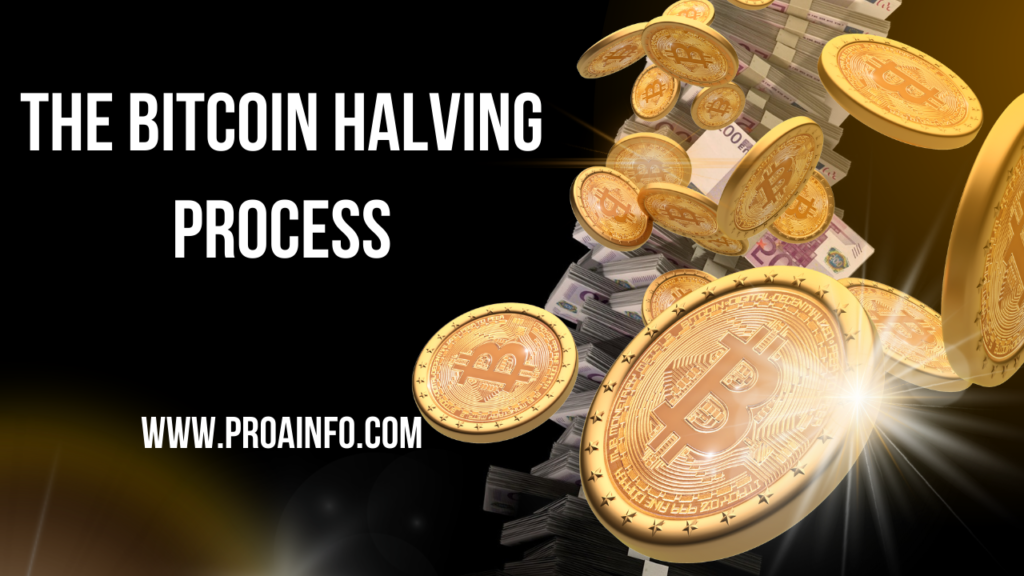What is Bitcoin Halving? Bitcoin is the world’s first and most well-known cryptocurrency, a decentralized digital currency that operates on a peer-to-peer network without the need for a central authority or intermediary. One of the unique features of Bitcoin is the concept of “halving,” which is a crucial event that occurs approximately every four years. This halving event has a significant impact on the supply and economics of Bitcoin, making it an essential aspect of understanding the cryptocurrency’s ecosystem.
The Bitcoin Halving Process:

Bitcoin has a finite supply, with a maximum of 21 million coins that can ever be mined. The process of creating new Bitcoins is called “mining,” where miners use specialized computers to solve complex mathematical puzzles. When a miner successfully solves a puzzle, they are rewarded with a certain number of newly minted Bitcoins.
Initially, the reward for mining a block was 50 Bitcoins. However, the Bitcoin protocol is designed to periodically reduce this reward by half, an event known as “halving.” This halving occurs approximately every 210,000 blocks, which translates to roughly every four years.
The primary purpose of the halving mechanism is to control the supply of Bitcoin and maintain its scarcity. By reducing the reward for mining, the rate at which new Bitcoins enter circulation slows down, ensuring that the total supply of Bitcoins never exceeds the predetermined limit of 21 million coins.
Historical Bitcoin Halving Events:
Since its inception in 2009, Bitcoin has undergone three halving events:
- The First Halving (November 28, 2012): The first Bitcoin halving took place on November 28, 2012, when the mining reward was reduced from 50 Bitcoins per block to 25 Bitcoins per block. At the time, Bitcoin was still in its early stages, and the halving event had a relatively minor impact on the market.
- The Second Halving (July 9, 2016): The second halving occurred on July 9, 2016, reducing the mining reward from 25 Bitcoins per block to 12.5 Bitcoins per block. This event garnered more attention from the cryptocurrency community and investors, as Bitcoin had gained significant traction and adoption by this point.
- The Third Halving (May 11, 2020): The most recent halving took place on May 11, 2020, cutting the mining reward from 12.5 Bitcoins per block to 6.25 Bitcoins per block. This event was highly anticipated by the crypto community and sparked intense speculation about its potential impact on the Bitcoin market.
Impact of Bitcoin Halving:

The Bitcoin halving event has far-reaching implications for various aspects of the cryptocurrency ecosystem, including:
- Supply and Scarcity: The primary impact of the halving is on the supply of new Bitcoins entering circulation. With each halving, the rate at which new Bitcoins are created is reduced by half, decreasing the overall supply and increasing the scarcity of the cryptocurrency.
- Mining Profitability: The halving event directly affects the profitability of Bitcoin mining. As the mining reward is reduced, miners receive fewer Bitcoins for their efforts, potentially making it less profitable to mine Bitcoin. This can lead to miners leaving the network or upgrading their hardware to remain competitive.
- Price Impact: The halving event is often considered a bullish event for Bitcoin’s price, as it reduces the supply of new Bitcoins entering the market. According to the economic principle of supply and demand, a decrease in supply while demand remains constant or increases can lead to an increase in price.
However, it’s important to note that the price impact of a halving event is not guaranteed, as it depends on various other factors, such as market sentiment, adoption rates, and overall demand for Bitcoin.
- Mining Difficulty Adjustment: The Bitcoin network is designed to adjust the mining difficulty level every 2,016 blocks (approximately every two weeks) to maintain a consistent block generation time of approximately 10 minutes. After a halving event, the mining difficulty is expected to decrease as some miners may leave the network due to reduced profitability. This adjustment aims to maintain a stable network and block generation rate.
- Adoption and Awareness: Bitcoin halving events generate significant media attention and public interest, which can contribute to increased awareness and potential adoption of the cryptocurrency. As more people learn about the scarcity and deflationary nature of Bitcoin, it may attract new investors and users to the ecosystem.
Future Bitcoin Halving Events:
According to the Bitcoin protocol, the next halving event is scheduled to occur approximately every four years after the previous one. Based on this timeline, the next Bitcoin halving is expected to take place in early 2024, reducing the mining reward from 6.25 Bitcoins per block to 3.125 Bitcoins per block.
As the Bitcoin network continues to grow and mature, each halving event becomes more significant and closely watched by the crypto community, investors, and analysts. The impact of future halving events on the Bitcoin market and ecosystem remains a topic of ongoing speculation and debate.
Investment and Trading Strategies Around Bitcoin Halving:
The Bitcoin halving event has become a significant event in the cryptocurrency market, attracting the attention of traders and investors alike. As a result, various trading strategies and investment approaches have emerged to capitalize on the potential price movements and market dynamics surrounding the halving.
- Buy and Hold (Long-Term Investment): One of the most common strategies is the “buy and hold” approach, where investors accumulate Bitcoin well before the halving event in anticipation of a potential price increase due to the reduced supply. This strategy is based on the belief that the halving will create scarcity and drive up demand, leading to a long-term appreciation in Bitcoin’s value.
- Trading on Volatility: Bitcoin halving events are often accompanied by increased market volatility, as traders and investors speculate on the potential impact of the event. Some traders may employ strategies such as swing trading or scalping to capitalize on short-term price fluctuations around the halving period.
- Derivatives Trading: Derivatives markets, such as Bitcoin futures and options, can provide additional trading opportunities around halving events. Traders may use these instruments to speculate on the future price movements or hedge their existing Bitcoin positions.
- Mining Strategies: For Bitcoin miners, the halving event directly impacts their profitability. Some miners may choose to upgrade their mining hardware or relocate to regions with cheaper electricity costs to remain competitive. Others may opt to diversify their mining operations by exploring other cryptocurrencies or mining pools.
- Diversification and Portfolio Management: Investors may consider diversifying their portfolios by incorporating other cryptocurrencies or assets that could potentially benefit from the increased attention and demand surrounding the Bitcoin halving event.
It’s important to note that trading and investment strategies around Bitcoin halving events should be approached with caution and careful analysis, as the cryptocurrency market can be highly volatile and unpredictable. Investors and traders should conduct thorough research, manage risk effectively, and seek professional advice if necessary.
Conclusion:
The Bitcoin halving event is a unique and crucial aspect of the cryptocurrency’s ecosystem, designed to control the supply and maintain the scarcity of Bitcoin. As the mining reward is reduced by half approximately every four years, the halving event has far-reaching implications for various aspects of the Bitcoin market, including supply, mining profitability, price dynamics, and adoption.
While the impact of each halving event is subject to speculation and debate, these events have historically generated significant attention and interest within the crypto community. As Bitcoin continues to evolve and gain recognition as a legitimate asset class, future halving events are likely to become even more closely watched and potentially influential on the broader cryptocurrency market.
For investors, traders, and miners alike, understanding the mechanics and potential implications of Bitcoin halving events is crucial for informed decision-making and strategic positioning within the dynamic and rapidly evolving world of cryptocurrencies.
If you have any query, feel free to contact us!








3 thoughts on “WHAT IS BITCOIN HALVING? [2024]”